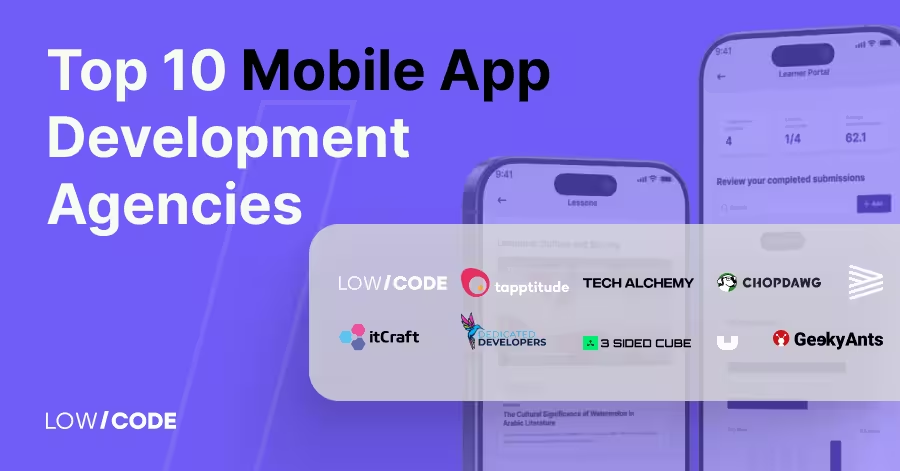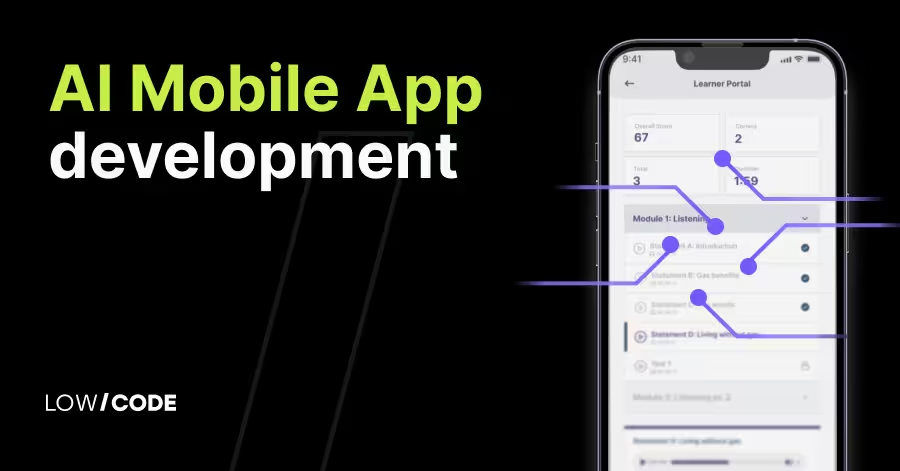How to Build a Food Delivery App with No-code
17 min
read
Learn how to build a food delivery app without coding using top no-code tools. Fast, affordable, and perfect for startups in 2025

Food delivery apps have become a big part of daily life. After the pandemic, people now prefer fast, contactless ways to order food. They want their favorite meals delivered quickly and safely. This shift in habits has made food delivery apps more popular than ever.
For business owners, this is a big chance. Many restaurants and solo founders are building their own food delivery apps. Why? To avoid paying high fees to third-party platforms and to connect with customers directly. Owning the app gives them full control over the customer experience, branding, and delivery process.
With the right no-code platform and planning, you can launch a working food delivery app in days, not months, and start growing your food business online.
Partner with LowCode Agency to Build Food Delivery Apps
At LowCode Agency, we've helped over 330 businesses transform their ideas into powerful, user-friendly applications using top no-code platforms. Our team specializes in building custom mobile apps that give you complete control over your customer experience and profit margins.
Ready to take control of your food delivery business? Book a free consultation call with our team today, and we'll show you how we can build your custom food delivery app in weeks, not months.
Read more | LowCode Agency's case studies
Why No-code Is Perfect for Food Delivery Apps
No-code development has revolutionized how food delivery apps are built, making them accessible to restaurant owners and entrepreneurs without technical backgrounds. Here's why no-code is the ideal approach for your food delivery app:
- Fast development with zero coding: Launch your app in weeks instead of months with intuitive drag-and-drop interfaces that don't require any programming knowledge. You can focus on the customer experience while the platform handles the technical details.
- Cost-effective for startups and solo founders: Save up to 80% on development costs compared to traditional custom coding. No-code platforms eliminate the need for expensive development teams, making food delivery apps financially viable even for small restaurants.
- Launch MVPs and scale without engineering teams: Start with a minimal viable product to test your concept, then add features based on real user feedback. No-code platforms allow you to grow your app organically without hiring engineers for each new iteration.
- Seamless integrations with existing systems: Connect your app to payment processors, mapping services, and restaurant management systems without complex API work. Most no-code platforms offer pre-built connections to popular services.
- Ongoing flexibility to adapt: Easily update your menu, delivery zones, or pricing structure yourself without calling developers for every change. This agility is crucial in the fast-moving food delivery market.
- Ownership of your customer data: Capture valuable insights directly rather than surrendering this information to third-party platforms. Build relationships with your customers and create targeted marketing campaigns.
Read more | Build a Fitness App with No-code
What Type of Food Delivery App Can You Build?
The beauty of no-code development is its flexibility to create different types of food delivery solutions based on your specific business model. Here are the main types of food delivery apps you can build without writing code:
- Single restaurant app: Create a dedicated platform for your restaurant with your complete menu, branding, and direct ordering system. This approach eliminates third-party commissions and gives you full control over the customer experience, from ordering to delivery tracking.
- Multi-restaurant aggregator: Build a marketplace that connects multiple restaurants with hungry customers in your area. This model allows users to browse different cuisines in one place while you earn through commissions, advertising, or featured listings from participating restaurants.
- Cloud kitchen delivery system: Develop a streamlined app for delivery-only kitchen operations that optimizes back-end processes. Focus on efficient order management, delivery zone optimization, and kitchen workflow integration without the need for in-app restaurant discovery.
- Niche/specialty delivery: Target specific food categories or dietary needs that mainstream apps overlook. Whether it's homemade foods, specialty cuisines, meal prep plans, or dietary-restricted options (keto, vegan, gluten-free), no-code tools let you create tailored experiences for these underserved markets.
- Subscription-based meal delivery: Build recurring revenue models with weekly meal deliveries or ingredient boxes that customers can manage through your app, complete with preference settings and flexible delivery scheduling.
- Hybrid pickup and delivery model: Create systems that offer both delivery and pickup options, potentially with different pricing tiers, to maximize convenience for your customers while optimizing operational costs.
Read more | Build a Social Media App with No-code
Must-Have Features for a No-code Food Delivery App
A successful food delivery app needs to serve multiple user types while providing a seamless experience. Here are the essential features to include when building your no-code food delivery solution:
- Customer panel: Create an intuitive interface where users can browse restaurants or menus, place orders with customizations, track delivery in real-time, and access order history. Include search filters for cuisine type, price range, and dietary restrictions to enhance the user experience.
- Restaurant panel: Develop a dedicated dashboard for restaurant staff to manage their menu items, update availability, receive and confirm orders, and track delivery status. This panel should allow for quick updates to pricing, descriptions, and special offers without technical assistance.
- Admin panel: Build a comprehensive management system to oversee all platform activities, including user management, restaurant onboarding, order monitoring, and performance analytics. This control center gives you visibility across the entire operation.
- Secure payment processing: Integrate multiple payment options including credit cards, digital wallets, and cash on delivery. No-code platforms typically offer ready-made connections to payment processors like Stripe and PayPal to handle transactions securely.
- Map integration: Incorporate location services to display accurate delivery areas, calculate delivery times and costs based on distance, and provide turn-by-turn directions for delivery personnel. This feature is crucial for managing customer expectations.
- Push notifications: Implement automated alerts to keep all parties informed throughout the order journey, from confirmation to preparation to delivery. These real-time updates reduce support inquiries and enhance customer satisfaction.
- Ratings and reviews: Include a feedback system that allows customers to rate their experience and provide comments, helping you maintain quality control and building trust within your platform.
- Loyalty program: Add features for rewards, points, and special offers to encourage repeat orders and build customer retention, which is more cost-effective than continuously acquiring new users.
Read more | How to Hire No-code Developers
Best No-code Platforms to Build a Food Delivery App
Choosing the right no-code platform is crucial for creating a food delivery app that meets your specific needs. Each platform offers distinct advantages depending on your project requirements, budget, and technical comfort level.
1. Bubble
Bubble is a powerful web and mobile application builder that excels at creating complex, data-driven platforms without code. Since its inception in 2012, Bubble has matured significantly, making it a standout choice for sophisticated food delivery solutions.
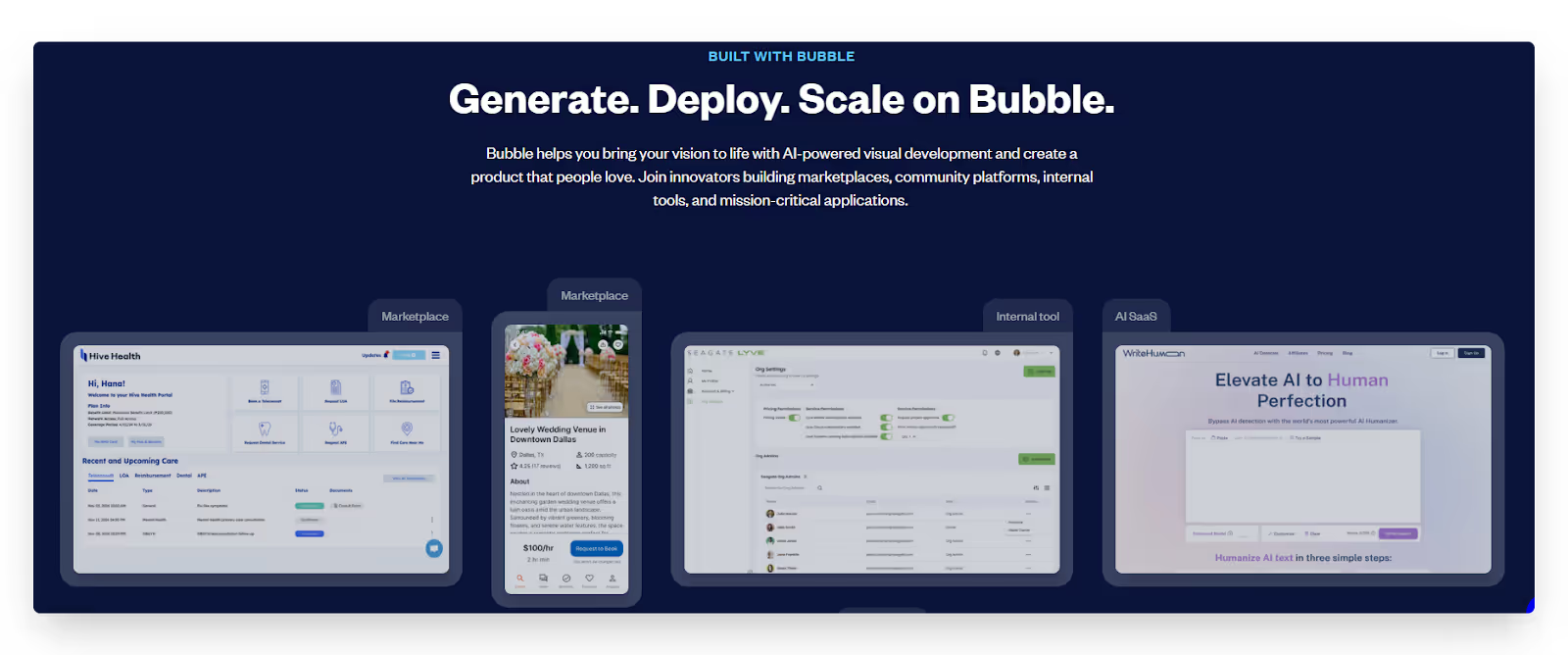
With Bubble's comprehensive database capabilities, you can easily manage restaurants, menus, users, and orders in one place. The platform offers extensive API connectors for seamlessly integrating payment gateways, mapping services, and notification systems, which are essential components of any food delivery app.
Read more | How to Hire Bubble Developers
Bubble truly shines when building feature-rich marketplaces that require sophisticated data relationships. It's particularly well-suited for multi-restaurant aggregators or delivery platforms that need complex filtering options, different user roles, and secure payment processing. The real-time data handling capabilities ensure customers can track their orders live, enhancing the overall user experience.
2. Glide
Glide transforms data sources into sleek, functional mobile applications with minimal setup time. This platform is perfect for restaurant owners who want to launch quickly without the technical complexity of other solutions.
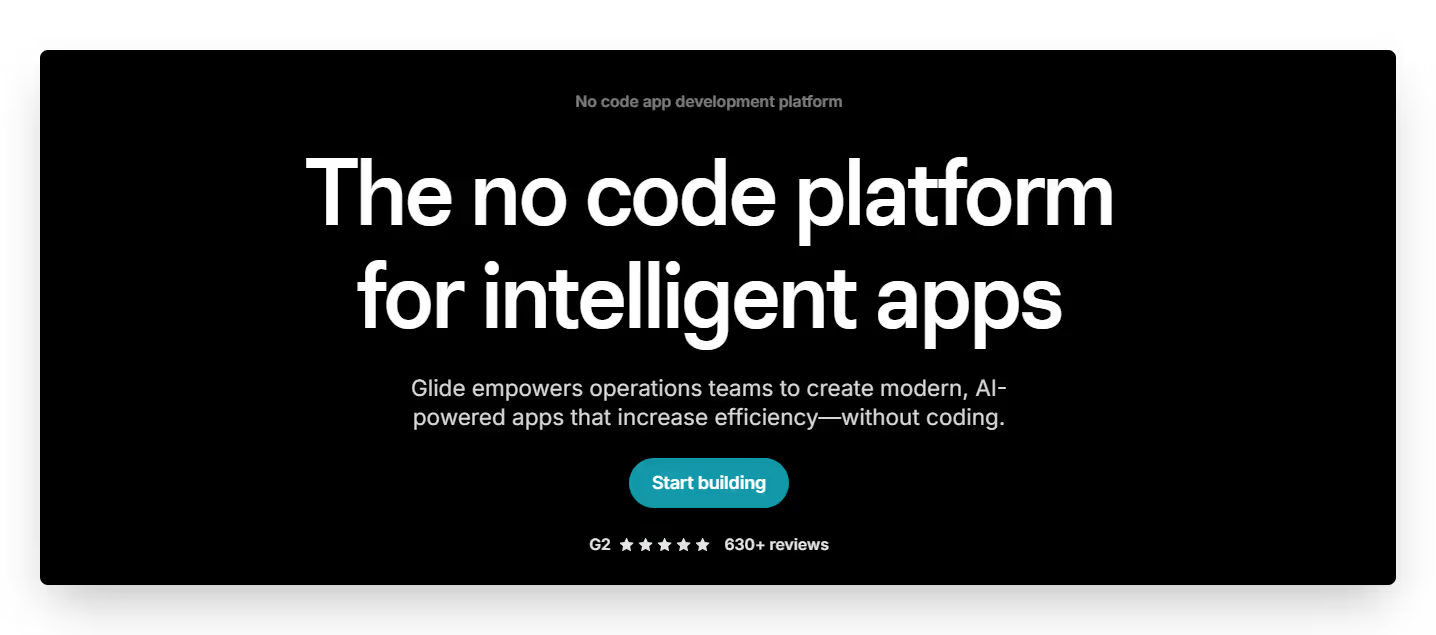
What makes Glide special is its spreadsheet-based data management that feels familiar and intuitive. You can create a professional-looking food delivery app in days rather than weeks, with all the essentials like menu displays, order processing, and customer profiles. The platform also offers offline capabilities – a crucial feature for delivery drivers who might work in areas with poor connectivity.
Glide is ideal for single restaurants or small operations looking to get started with minimal investment. The platform excels at creating simple but effective apps that focus on core functionality rather than complex features, making it perfect for businesses testing the waters with their own delivery service before committing to more advanced solutions.
Read more | Glide Review
3. FlutterFlow
FlutterFlow revolutionizes mobile app development by transforming complex code into an intuitive visual experience. It's the go-to choice for businesses seeking a polished, native mobile experience with superior performance.
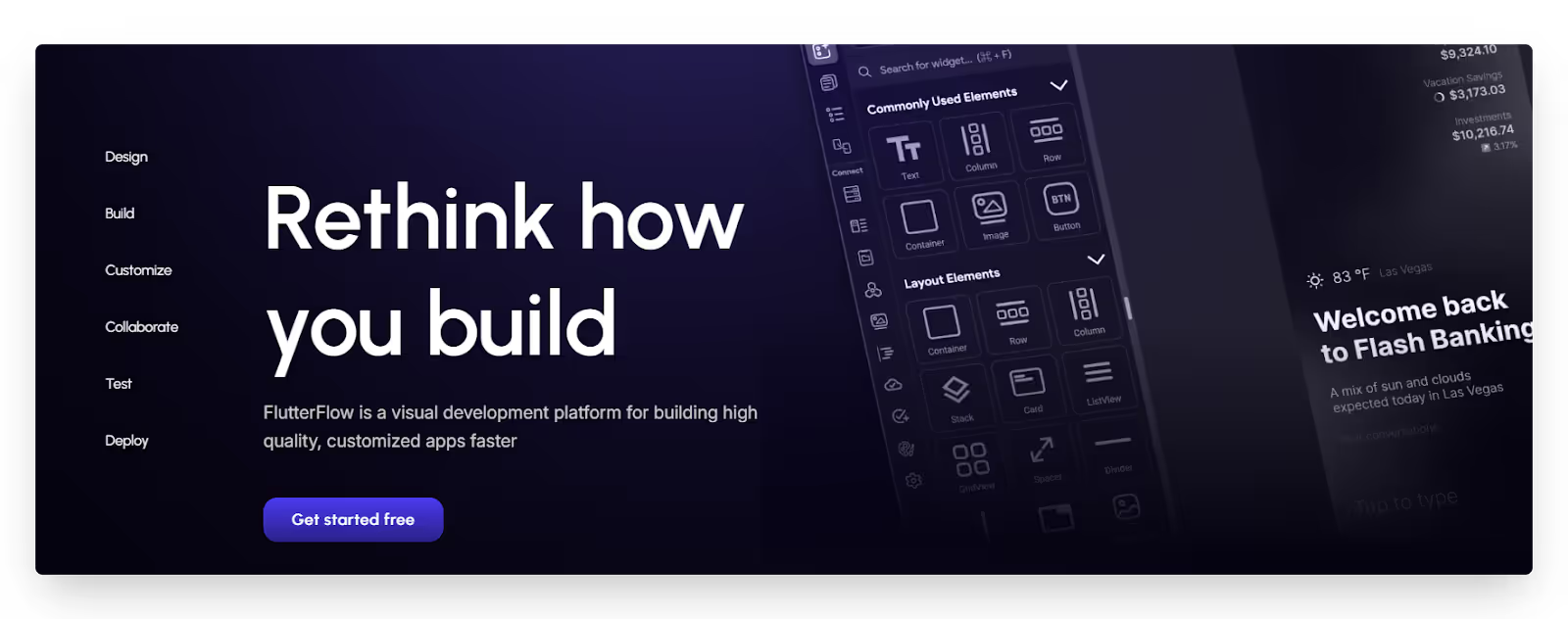
The platform enables you to build true native apps for both iOS and Android simultaneously, ensuring your food delivery service provides a premium experience on any device. FlutterFlow's advanced UI customization tools allow for sophisticated designs that can compete with major delivery apps in terms of look and feel.
The platform's sophisticated animation capabilities also allow for interactive elements that enhance user engagement, while robust backend integration options make it easy to connect with payment systems and location services.
Step-by-Step: How to Build a Food Delivery App
Creating your food delivery app doesn't have to be complicated. Follow this proven roadmap to bring your vision to life without writing a single line of code.
1. Choose your delivery model
Start by deciding exactly what type of food delivery service you want to build. Are you creating an app for your single restaurant or launching a multi-restaurant marketplace? Perhaps you're focusing on a niche market like homemade foods or specialty diets.
This decision will shape everything from your feature set to your revenue model. Consider factors like your target market, competition, and operational capabilities before proceeding. A focused approach will help you build a more effective solution than trying to be everything to everyone.
Read more | eCommerce Mobile App Development Guide
2. Hire an Expert
While no-code platforms make app development accessible, partnering with experienced professionals can save you months of trial and error. At LowCode Agency, we've built over 330 custom applications across industries, including multiple food delivery solutions.
Our team understands both the technical aspects of no-code development and the specific business requirements of food delivery operations. We can guide you through platform selection, feature prioritization, and launch strategies based on what's worked for similar businesses.
Working with experts also ensures your app follows best practices for security, performance, and user experience – critical factors for retaining customers in the competitive food delivery market.
Read more | Our Working Process
3. Design your UI using drag-and-drop tools
Your app's visual design creates the first impression for users. Use the intuitive drag-and-drop interfaces provided by no-code platforms to craft an engaging, intuitive experience.
Focus on creating clean, appetizing food displays with high-quality images. Design an intuitive ordering flow that makes it easy for hungry customers to find what they want and check out quickly. Consider how your brand colors, typography, and overall aesthetic will appeal to your target audience.
Remember that simplicity is key – restaurant apps with complicated interfaces tend to lose customers before they complete their orders. Prioritize clarity and ease of use over flashy design elements.
4. Set up your backend
The backend of your food delivery app manages all the essential data: menus, restaurants, user profiles, and orders. This is where the real power of no-code platforms becomes evident.
Create data structures that organize your food items with categories, prices, and customization options. Build user management systems that store delivery addresses, payment methods, and order history. Set up restaurant profiles with operating hours, delivery zones, and preparation times.
Take time to organize these elements thoughtfully, as a well-structured database will make it easier to add features and scale your app in the future.
Read more | Best Backends for Bubble
5. Add workflows: place order, assign delivery, notify users
Workflows are the automated processes that bring your app to life. These are the sequences of actions that happen when users interact with your app.
Create workflows for the entire customer journey: browsing menus, adding items to cart, placing orders, processing payments, and tracking deliveries. Then build restaurant-side workflows for receiving orders, confirming them, updating preparation status, and assigning deliveries.
Include automated notifications at each stage to keep all parties informed. These real-time updates dramatically improve the user experience and reduce support inquiries.
Read more | Business Process Automation Benefits
6. Integrate payments and maps
Secure, reliable payment processing is non-negotiable for food delivery apps. Integrate payment providers like Stripe or PayPal to handle transactions safely.
Next, implement mapping functionality to display delivery zones, calculate delivery fees based on distance, and provide navigation for delivery personnel. These integrations are typically straightforward with no-code platforms, which offer pre-built connectors to popular services.
Consider offering multiple payment options including credit cards, digital wallets, and cash on delivery to accommodate different customer preferences.
Read more | Cross-Platform Mobile App Development Guide
7. Test user roles
Your app serves different types of users: customers, restaurant staff, delivery personnel, and administrators. Each needs a different interface and permissions.
Test thoroughly from each perspective to ensure everyone has the tools they need without unnecessary complexity. Have real restaurants and customers participate in your testing to uncover usability issues and gather valuable feedback.
Pay special attention to edge cases like order modifications, cancellations, delivery delays, and payment failures to ensure your app handles unexpected situations gracefully.
8. Launch MVP and collect feedback
Rather than waiting to build the perfect app, launch a Minimum Viable Product (MVP) with core features that solve the fundamental needs of your users. This approach allows you to gather real-world feedback quickly and iterate based on actual usage patterns.
Implement analytics to track key metrics like order completion rates, average order values, and user retention. Create simple ways for users to provide feedback directly within the app.
Listen carefully to what your early users tell you – their insights will guide your roadmap for future features and improvements. Remember that successful food delivery apps evolve continuously based on user behavior and market trends.
Read more | How to Choose MVP Features
Common Challenges and How to Solve Them
Even with no-code platforms, building a food delivery app comes with specific challenges. Here's how to overcome the most common hurdles you'll face during development:
- Live location tracking: Real-time delivery tracking can be difficult to implement without code. Solve this by using specialized plugins available on platforms like Bubble that connect with mapping APIs. Alternatively, implement a simpler status-based tracking system (preparing, out for delivery, nearby) combined with estimated delivery times as a starting point.
- Delayed notifications: Timely alerts are crucial for food delivery, but notification delays can frustrate users. Implement redundant notification channels (push, SMS, and email) to ensure important updates reach users. Configure webhook triggers to fire immediately when status changes occur, and use dedicated notification services like OneSignal or Twilio for more reliable delivery.
- Complex business logic: Managing various scenarios like restaurant operating hours, delivery zones, and special instructions can become complicated. Break down complex processes into smaller, manageable workflows. Use decision trees to map out all possible scenarios before building, and implement progressive complexity; start with basic functionality and add sophistication gradually.
- Scaling issues: As your user base grows, performance can suffer. Prepare for scaling by optimizing your database structure from the beginning, limiting unnecessary data queries, and caching frequently accessed information. Choose platforms with proven track records for handling high volumes of simultaneous users, and implement load testing before major launches.
- Payment processing security: Handling financial transactions requires robust security measures. Rather than building payment processing yourself, integrate established payment gateways that handle security compliance. Implement proper data encryption and access controls, and follow security best practices recommended by your platform provider.
- Managing peak demand periods: Food delivery apps often experience surge periods (lunch, dinner, weekends). Design your system with these peaks in mind by implementing queuing mechanisms for orders during high-volume periods and setting reasonable expectations for delivery times during rush hours. Consider offering incentives for off-peak ordering to distribute demand more evenly.
Read more | Bubble MVP App Development
Cost to Build a Food Delivery App Using No-code
Building a food delivery app with no-code tools is significantly more affordable than traditional development, but costs can still vary widely depending on your specific needs and chosen platform. Understanding the full financial picture helps you budget appropriately and avoid unexpected expenses.
Platform Pricing and Development Range
No-code platforms offer a range of pricing models, typically based on features, usage, and scalability:
- Glide: Starts free, but functional apps for restaurants usually fall under the $99–$249/month range depending on row limits, users, and integrations. Ideal for small-scale or single-restaurant apps.
- Bubble: Offers a robust free tier, but production-level plans (with custom domains and API access) start at $32/month, with scalable options up to $475/month or more. Best for complex delivery marketplaces or custom flows.
- FlutterFlow: Pricing begins at $30/month, with access to API integration and Firebase. For production apps and custom code export, the $70–$100/month range is more realistic.
Beyond platform costs, consider development expenses. The approach you choose significantly impacts both your budget and results:
DIY development appears cost-free initially but carries substantial hidden costs. The learning curve requires 3-6 months of time that could be spent running your business. Additionally, inexperience often leads to poor design, security and development choices that becomes expensive to fix later.
Agency development with LowCode Agency ranges from $15,000-$40,000, with a clear roadmap defined from our very first calls. Our approach goes beyond simply building your app, we become true partners in your journey. We don't deliver and disappear; instead, we establish a collaborative relationship where we're invested in your long-term success.
Add-On Costs (APIs, Plugins, Automation Tools)
Beyond base platform fees, your app might require additional tools and integrations:
- Payment processing: Services like Stripe charge 2.9% + $0.30 per transaction. Some platforms may require additional payment connector plugins ($20-$100/month).
- Mapping services (Google Maps API): Google Maps offers limited free usage, then charges based on volume. Budget $5–$25/month for startups.
- Automation (Zapier, Make): Pricing varies from free to $49+/month, depending on task volume and app complexity.
- Push notification tools (OneSignal, Twilio): Basic plans are free; business-level plans can reach $50+/month.
- Custom domains, email notifications, analytics tools: These extras typically add $10–$100/month, depending on your tech stack and user base.
What’s Next After Launch?
Launching your food delivery app is just the beginning of your journey. The post-launch phase is crucial for growth, refinement, and securing your place in the market. Here's how to make the most of this critical period:
- Track performance with built-in analytics: Start collecting and analyzing user behavior data immediately after launch. Monitor key metrics like order completion rates, average order values, customer retention, and peak usage times. These insights will guide your optimization efforts and help identify both strengths and weaknesses in your current offering.
- Implement specialized analytics tools: While basic platform analytics provide a good starting point, consider adding specialized tools for deeper insights. Mixpanel helps track user journeys through your app, PostHog offers open-source product analytics with session recordings, and Glide Analytics provides accessible metrics for non-technical users. These tools reveal patterns that basic analytics might miss.
- Gather and implement user feedback: Create multiple channels for users to share their experiences and suggestions. In-app feedback forms, follow-up emails, and user interviews are all valuable sources of insight. Prioritize addressing common pain points first, and communicate improvements to users so they know their feedback matters.
- Optimize operational efficiency: Use real-world data to refine your backend processes. Identify bottlenecks in order processing, look for ways to reduce delivery times, and streamline restaurant operations based on actual usage patterns. Small improvements in efficiency can significantly enhance the user experience.
- Add advanced features gradually: Once your core functionality is stable, begin implementing more sophisticated features based on user needs. Consider loyalty programs to increase retention, personalized recommendations based on order history, or subscription options for regular customers. Introduce one new feature at a time to properly measure its impact.
- Expand thoughtfully: If your initial launch proves successful, consider strategic expansion. This might mean adding more restaurants to your platform, expanding delivery zones, or introducing new cuisine types. Base these decisions on data rather than assumptions, and ensure your infrastructure can handle the additional load.
- Stay competitive through innovation: Keep an eye on market trends and competitor offerings. Food delivery is a dynamic industry, and staying relevant requires continuous innovation. AI-powered recommendations, voice ordering, or integration with smart home devices might provide your next competitive edge.
Conclusion
Yes, you can create a fully functional food delivery app without writing code. With platforms like Glide, FlutterFlow, and Bubble, it's now faster, cheaper, and flexible enough to launch and grow, even with a small team.
Whether you're a single restaurant looking to eliminate third-party commissions or an entrepreneur spotting a gap in the food delivery market, the barriers to entry have never been lower. You can start small with a focused MVP, gather real customer feedback, and expand your features as you grow.
Ready to take the next step? Book a free discovery call with our team today. Let's discuss your vision for a food delivery app and create a clear roadmap to bring it to life, without writing a single line of code.
Created on
July 11, 2025
. Last updated on
December 31, 2025
.

FAQs
Can I build a food delivery app like DoorDash or Uber Eats without coding?
What is the best no-code platform for building a food delivery app?
Is real-time delivery tracking possible with no-code tools?
How long does it take to build and launch a no-code delivery app?
Can I monetize my food delivery app built with no-code?
What are the limitations of using no-code for food delivery apps?





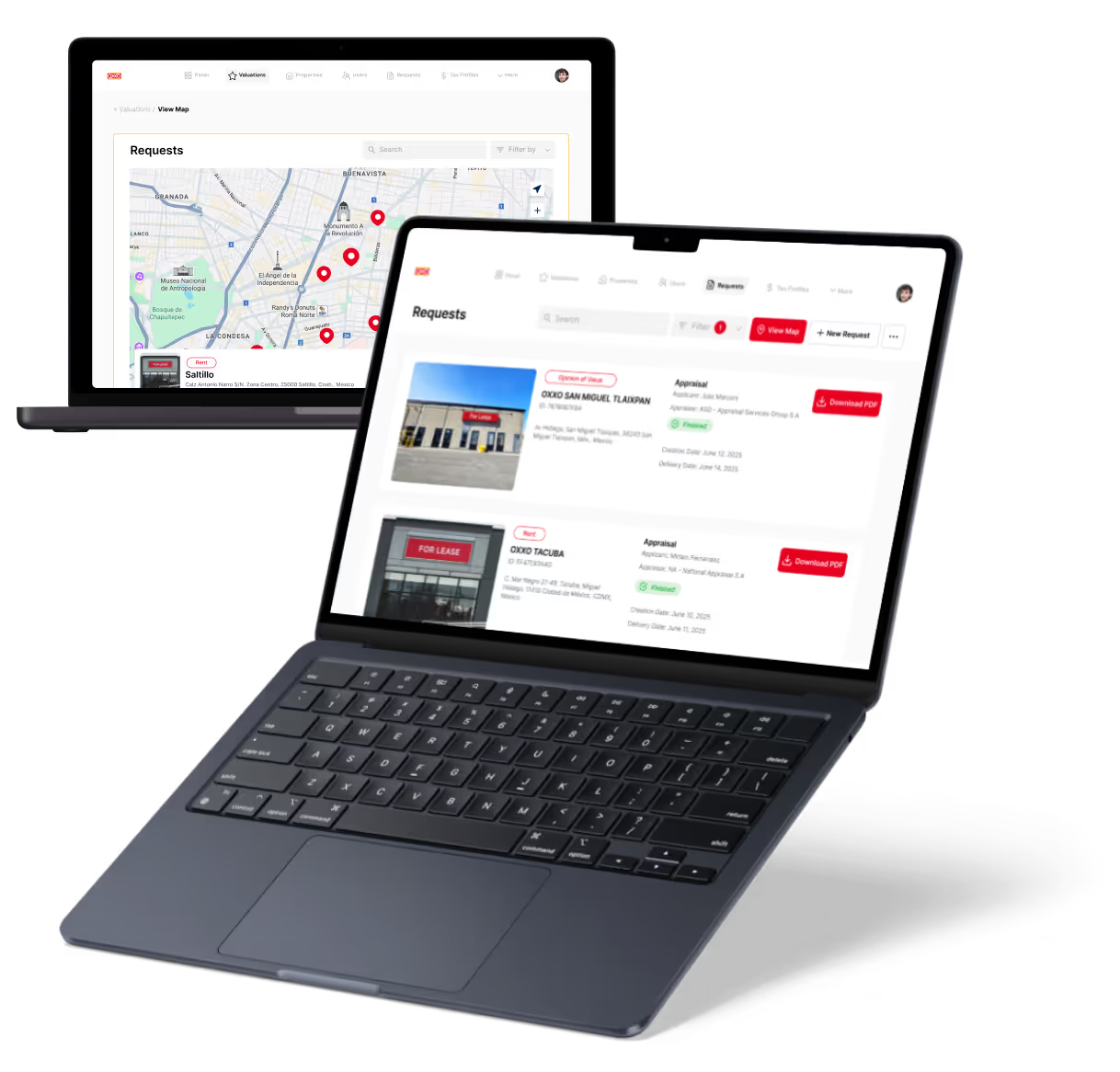

%20(Custom).avif)




